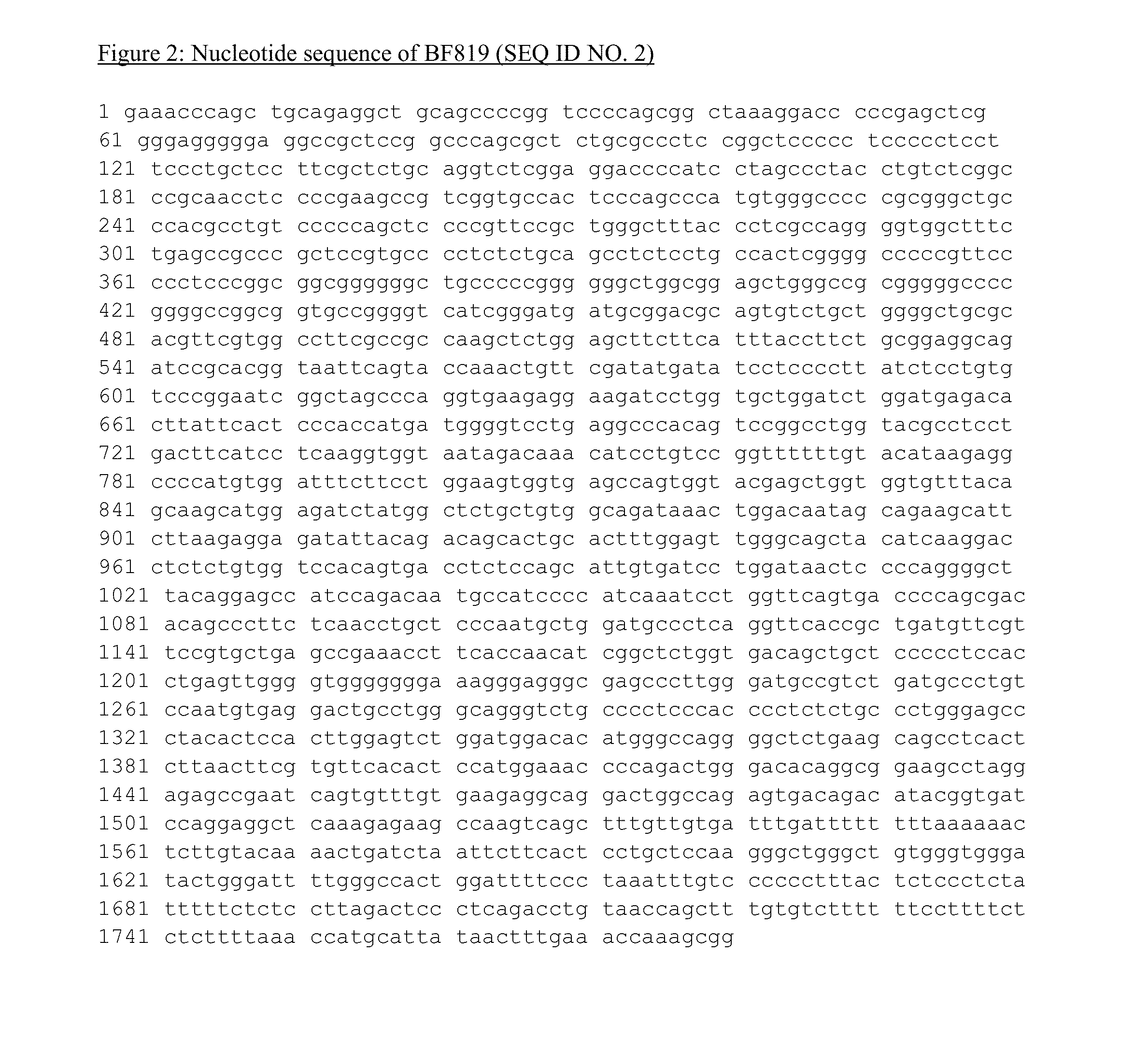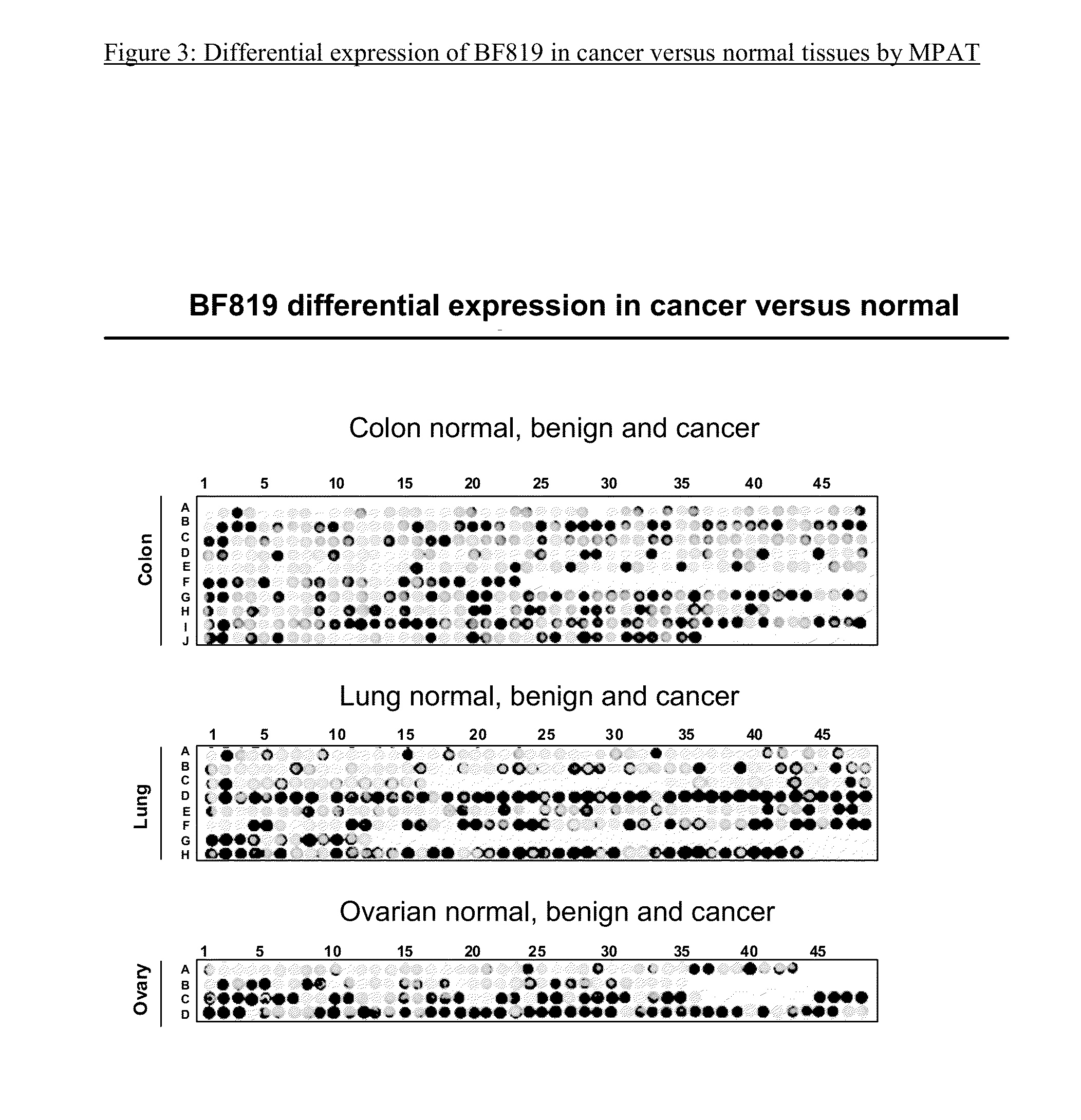Biological marker for early cancer detection and methods for cancer detection (BF819)
a biological marker and cancer detection technology, applied in the field of biological markers for early cancer detection and cancer detection methods, can solve the problems of limited success, many have actually reached the clinical setting, and the cost of cancer treatment exceeds half a trillion dollars
- Summary
- Abstract
- Description
- Claims
- Application Information
AI Technical Summary
Benefits of technology
Problems solved by technology
Method used
Image
Examples
example 1
Epitope Analysis by Phage Display
[0190]The amino acid sequence within the marker of the present invention that is recognized by the mAb is defined as the “epitope”. To find the epitope harbored by the marker of the present invention, a phage display approach was employed using the New England Biolabs PhD-12 Phage Display Library Kit according to the manufacturer's instruction manual. A brief description of the protocol follows.
[0191]The phage library has a titer of 1013 pfu / ml. Ten microliters of the library are incubated in TBST (50 mM Tris-HCl pH 7.5, 150 mM NaCl, 0.1% Tween 20) with the mAb BF819 for 1 hr at RT. The mAb is immobilized on a plastic surface, such as an ELISA 96 well plate, via a rabbit mouse IgG (see below). This represents a ˜1011 pfu input, i.e. a ˜100 fold representation of a library with a complexity of 109 individual clones, each harboring five copies of a 12-mer peptide embedded in the phage capsid. After incubation and washing of unbound phages in TBST, boun...
example 2
Determination of Marker BF819 Identity
[0197]The consensus epitope of mAb BF819 of the present invention, as determined from the phage display approach (Example 1 above), must be present in the amino acid sequence of the protein marker.
[0198]Thus, the protein identity BF819 is determined upon BLAST search of the consensus epitope in the NCBI protein database. Specifically, the consensus epitope or alternatively the 12-mer peptide with the best ELISA binding is entered in a BLAST search (blast.ncbi.nlm.nih.gov) to retrieve all possible proteins with a degree of homology to the consensus epitope or queried peptide of up to 80%.
[0199]Bm identity and its protein sequence is determined upon correlation with other specific marker data presented herein (western blot, molecular weight, subcellular localization, biomarker expression by IHC etc.) and other databases, such as Human Protein Atlas (www.proteinatlas.org) and UniProt database (www.uniprot.org).
example 3
Matrix Protein Array Screening Technology
[0200]The matrix protein array technology (MPAT) is a multiplex protein array immunoassay developed by the Applicant for the simultaneous analysis of multiple biological samples, under the same conditions. The MPAT has been used for the immunodetection of protein marker / mAb of the present invention in a variety of protein samples, as detailed in the examples below.
[0201]The solid support of the matrix protein array may be composed of a different number of chambers or compartments of different sizes, depending on the scope of the investigation. In its simplest format, the MPAT is composed of 96 chambers. Other formats can be used, depending on the number of antibodies to assay, and the number of samples to screen. Biological samples are spotted or printed (see below) in a matrix arrangement within each compartment on a nitrocellulose membrane. The same matrix of clinical samples, including normal and diseased, or the same matrix of protein ext...
PUM
 Login to View More
Login to View More Abstract
Description
Claims
Application Information
 Login to View More
Login to View More - R&D
- Intellectual Property
- Life Sciences
- Materials
- Tech Scout
- Unparalleled Data Quality
- Higher Quality Content
- 60% Fewer Hallucinations
Browse by: Latest US Patents, China's latest patents, Technical Efficacy Thesaurus, Application Domain, Technology Topic, Popular Technical Reports.
© 2025 PatSnap. All rights reserved.Legal|Privacy policy|Modern Slavery Act Transparency Statement|Sitemap|About US| Contact US: help@patsnap.com



